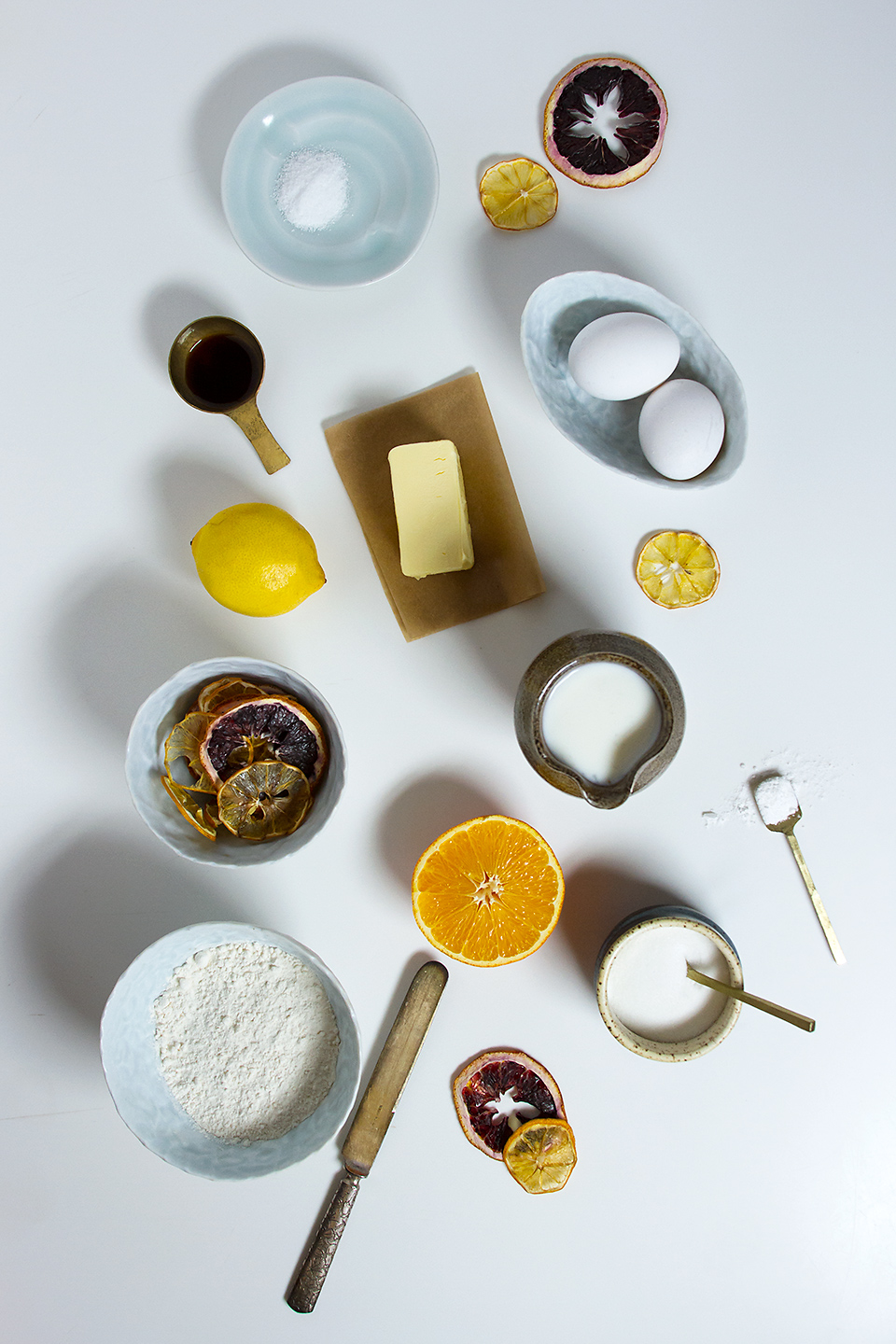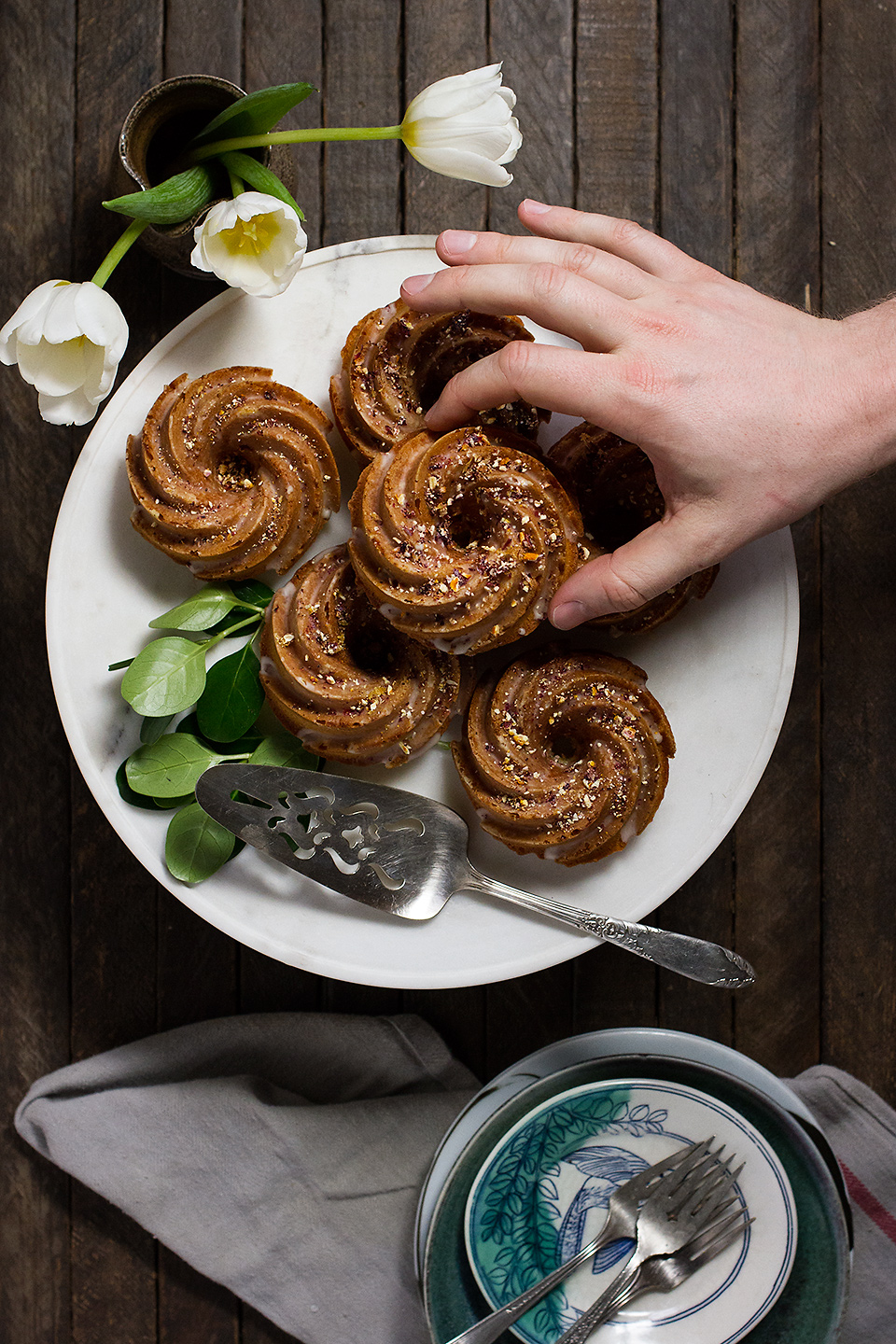A perfect pound cake is a thing of beauty. Finely textured, tight crumb, light, moist. When a pound cake is good, it’s great. And, that’s the best part, it doesn’t need anything else to stand on its own. But more often than not, what you get is a dense, dry, flavorless slab that even ice cream can’t save.
The pound cake is a humble cake when even more humble origins. Traditionally it is prepared by mixing together a pound of butter, a pound of sugar, a pound of eggs, and a pound of flour, hence the name. While that doesn’t sound remarkable, what you get is a cake that truly highlights the flavor of the eggs and all that butter.
After testing a lot of cake, I strayed from the classic 1:1:1:1 ratio by adding milk for extra moistness and tenderness. I know, I know it’s not traditional, but the dairy so improves the texture that it wins hands down when tasted side-by-side to a more traditional preparation. The flavor is slightly less buttery but noticeably moister and lighter. Once doused in glaze, it’s the perfect specimen of a pound cake.
[A huge shout out to my friends who I forced to eat all my kitchen failures. Sorry, not sorry.]
Regardless if you prefer a lighter, moister cake or a denser, buttery cake, the technique is just as critical. Pound cake has such few ingredients, so treat them with care. That means cream your butter right and emulsify your fats well.
So, why does this matter?
Remember all those seemingly unnecessary steps that say to use room temperature butter and to cream your butter until light and fluffy? I’m sure your internal baking monologue is saying “Ugh, all of this is getting in between me and cake.” Well, those are essential. If there was a stronger word for it I’d used it. If you don’t believe me, check out some of these sites, which show you what happens when you skip over these steps.
Not pretty.
The reason all of this is so important is because the beaten sugar cuts pockets of air in the butter and that helps the cake rise and form its crumb. Properly creamed butter should be noticeably lighter in color and less gritty. Brave Tart has an excellent post about the ins and outs and what that should look like (take a look!). On a standard Kitchen Aid stand mixer, this will take about 3 to 4 minutes at medium speed (a 4 on a KitchenAid stand mixer) to cream the butter and sugar.
But, whip too long and things start to heat up. Once butter rises past 68°F, it begins to melt and can’t easily form an emulsion with the eggs. All you need to know is that means goodbye to that even crumb we’re after. To ensure your butter doesn’t go beyond 68°F, start with butter that is at least 60°F and no more than 65°F. I go so far to use an instant-read thermometer to be sure. It’s that important.
Once your butter is perfection you need to emulsify the eggs into the fat. Serious Eats does another great job explaining but essentially a stable emulsion of fat and liquid ensures a springy cake and even crumb. Done wrong and the batter will break and look curdled. If you have ever made a vinaigrette, you know what I mean.
You need to incrementally incorporate the eggs into the fat one at a time mixing well in between. This gradual addition makes it easier to disperse the eggs throughout the fat evenly. The egg yolks promote emulsification while the egg whites provide structure and aeration as they whip. Plan on beating the eggs for a full minute between additions at medium speed.
This is about getting lightness and even crumbs people!
If you follow these steps, you’ll be rewarded with a straight up addictive pound cake. I like to serve this on is own or with whipped cream. It’s so good that even if it goes stale just toast it up with some butter in a pan and serve with macerated berries.
What worked: I use two glazes here to add lots of citrus flavor. The first glaze uses granulated sugar to add crunch. The second glaze uses confectioner’s for the iconic white coating.
What didn’t: Consider doubling the glaze recipe and adding another layer of glaze to really get that white glaze effect.
Know this: With such few ingredients, technique counts. Take your time to properly warm the ingredients and cream the butter and sugar. If you rush these critical steps, the cake will turn out dense and crumbly.
Perfect Pound Cake
Pound Cake
- 495 g (2 and 1/2 cups) granulated sugar
- 340 g (1 and 1/2 cups) unsalted butter – room temperature
- 390 g (3 and 1/4 cups) all-purpose flour (1 cup = 120 g)
- 2 teaspoon baking powder
- 1 teaspoon kosher salt
- 6 large eggs – room temperature
- Zest of 1 lemon
- 6 oz (3/4 cup) whole milk – room temperature
- 2 teaspoons vanilla extract
Crunchy Citrus Pre-Glaze
- 50 g (1/4 cup) granulated sugar
- 1 tablespoon lemon juice
- 1 tablespoon orange juice
Citrus Glaze
- 128 g (1 cup) confectioner’s sugar
- 1 tablespoon lemon juice
- 1 tablespoon orange juice
- Crushed freeze dried fruit – optional
Steps
Bake the Cake: Bring the cold ingredients to room temperature. The butter should be soft where you can easily press your thumb into it, about 60°F.
Preheat the oven to 325°F.
Grease a 10-inch bundt and dust lightly with flour. Tap the pan to dump out the excess flour.
Sift to combine the flour, baking powder, and salt in a medium bowl and set aside. Mix the milk, lemon zest, and vanilla together in a large measuring cup.
Add the butter and sugar to the bowl of an electric mixer fitted with the paddle attachment. Cream the butter and sugar on low until blended, about 30 seconds. Increase the speed to medium (a 4 on a KitchenAid stand mixer) and beat until pale and fluffy, about 3 to 4 minutes. Add the eggs one at a time, beating for a full minute after each addition. Scrape the bowl with a spatula between additions.
With the mixer on low, alternate adding 1/3 of the flour mixture followed by 1/2 of the liquid mixture, beating until combined after each addition. Scrape the bowl with a spatula between additions.
Transfer the batter to the bundt pan and smooth with a spatula. Bake until golden and a skewer inserted in the center of the cake comes out clean, about 50-60 minutes.
Cool the cake for 30 minutes and then carefully turn out onto a wire rack to cool completely.
Glaze the Cake: While the cake cools prepare the glazes. I like to set the cooling rack on a sheet tray to catch any glaze drippings.
To make the pre-glaze, stir together the granulated sugar, lemon juice, and orange juice in a small bowl. Brush the entire warm cake with the glaze, then let the cake cool completely to form a crunchy crust.
When the cake is cool, stir together the confectioner’s sugar, lemon juice, and orange juice in a small bowl. Let sit for a minute to thicken and then drizzle over the top of the cake.
Crush the freeze dried fruit with your hand as you sprinkle it over the cake.



















Keith @ How's it Lookin? says
I gotta try this. It definitely does look perfect, thanks for sharing
Evan says
Thanks! Let me know how it turns out!!
Thalia @ butter and brioche says
This is SO beautiful. Love the photos especially X
Evan says
Thanks for the kind words! If you end up making the cake, let me know how it goes. I’d love another opinion in my quest for the perfect pound cake!
Jenniq says
Lovely cake and wonderful explanation of why temperature and mixing methods are so critical. I’ve refined my technique even a bit more by beating the eggs and then drizzling them into the batter over about a 5 minute period. Give that a shot next time and see what you think! And also–big yes to the double glaze. Next pound cake I make will be a double-glazed beauty. Thanks!!
Evan says
I’ll have to give that a try next time! I spent hours and hours reading about mixing methods and am surprised at how quickly most recipes gloss over it. Enjoy!
Yvette says
Hello,
May I ask, where you bought the cake pan?
Evan says
Hello! I believe I purchased it from Williams Sonoma!
Thom says
I’m curious, and before I go through my own experimentation, did you try the cake with just the pre-glaze? If so, what did you think?
Thanks for all the tips. Methods and techniques are just as important as ingredients.
Evan Kalman says
Hi Thom! I felt that without the pre-glaze, it wasn’t as tart as I wanted. The powdered sugar glaze is a bit too sweet and gets too runny if you add more lemon juice. That said, it is TOTALLY optional! Let me know how it turns out.
Thom says
Hi Evan — Thanks for the reply. My question was the other way around. Did you try the cake WITH just the pre-glaze… and WITHOUT the powdered sugar glaze?
I’m not a fan of sweet, powdered sugar glaze/icing. If you haven’t tried it with the pre-glaze only I’ll try it on half the cake and report back.
I just stumbled across your blog while looking for a pound cake recipe. What an awesome site!
Thom
Thom says
Hi Evan — Reporting back.
I’m not much of a cake eater, but I love pound cake. I prefer classic style pound cakes that are all about the texture and the mild flavor with hints of butter and vanilla and maybe nuanced with almond or lemon. Anything else is just a cake influenced by a pound cake recipe. I made your Perfect Pound Cake last Thursday; it was gone Saturday. It will now replace my long standing #2 go-to pound cake recipe.
I glazed half of the cake (top and sides while still warm) with the pre-glaze (fresh squeezed lemon and orange juices and sugar) and left the other half un-glazed. I did not use the powdered sugar glaze. The pre-glaze provided a nice zing of citrus without over powering the delicate balance of butter, vanilla and lemon (zest in batter). The pre-glaze is definitely an option to use in the future along with going “naked” — no glaze at all.
Thanks for sharing a really good recipe.
Thom